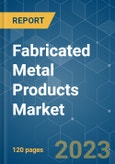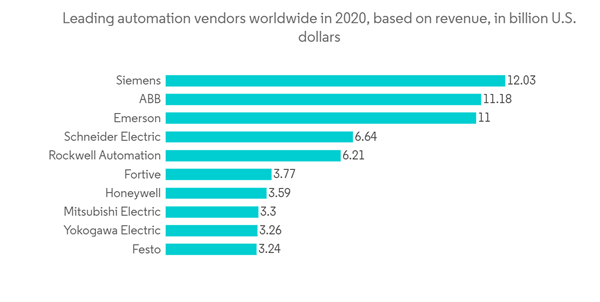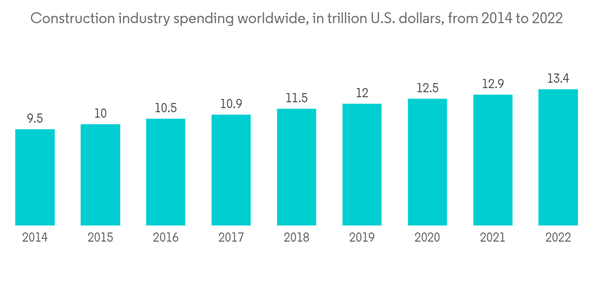The size of Fabricated Metal Products Market is USD 23.1 billion in the current year and is anticipated to register a CAGR of over 4% during the forecast period.
In addition, automated tools like laser saws help fabricators produce precisely cut metal parts more quickly. Various end-use industries use fabricated metals, including the automotive, oil & gas, construction, aerospace, agricultural, consumer product, medical device, and military & defense sectors. The effects of the metal fabrication industry's cyclical nature are lessened as a result of the diversification of end-use sectors.
Additionally, the metal manufacturing business makes use of a variety of ERP technology and applications. This facilitates data accessibility and quickens the fabrication industry's decision-making process. The metal fabrication sector is benefiting from increased use of computer-aided manufacturing technologies by improving operational effectiveness and production
Given that metal welding is the most widely utilised industrial process, it is projected that this market category will hold a significant portion of the overall metal fabrication market. During the forecast period, there is expected to be an increase in the use of metal welding due to the sizeable construction and automotive bases in developing nations like China, India, and Japan.
China continues to be a desirable site for investments, foreign direct investment from China into Asia was at historic highs. However, given cost rises as the nation goes up the value chain and diversifies its supply chains, it should be assumed that the recent shift in manufacturing production from China to countries like Vietnam and Indonesia will continue. It is anticipated that developing nations like China, India, and Japan will have substantial building and automobile industries.
The competition amongst service providers is further heightened by the strict regulatory requirements that must be met. Businesses participate in M&A transactions to develop their product lines and expand regionally.
Key Highlights
- The profitability of the metal fabrication business depends on economic growth because demand is a function of the economy. Metal fabrication has developed into a significant and vigorous industry that keeps recalibrating and thriving since the economic recovery following the previous recession. Automated fabrication is the main market driver for the global market for metal fabrication services. Prices for fabrication services have decreased as a result of automation. The fabrication process is now more effective thanks to automation. Fewer accidents happened throughout the fabrication process as a result of automation.
- Factors such as rising demand for low-emission ICE vehicles. Increasing consumer spending on safety and comfort features in automobiles and the growing trend of electrification of automobiles along with the growing demand for premium vehicles will lead to a growth in the global fabricated metal products market. The global recovery from the pandemic will also be a major factor leading to stable growth in demand for these fabricated metal products.
- One of the major factors propelling the market under study recently is an increase in demand from the building and construction industry, with the Asia-Pacific construction sector being the largest globally. Moreover, according to the National Development and Reform Commission of China, the Chinese government approved 26 infrastructure projects at an estimated investment of about USD 142 billion in 2019, which are expected to be completed by end of 2023. The growing infrastructure investment and building of complex structures are expected to drive the Fabricated Metal Products market.
- The automotive, aerospace, construction, and energy industries all depend on the metal fabrication sector, which is itself very cyclical. The market and economic elements influencing each sector's markets determine the earnings for each industry. Investors need to consider their specific clientele and the economic factors that may be having an impact on them at any given time. The cyclical nature of the industry can be better managed by diversifying the customer base and attracting clients from a variety of sectors.
Fabricated Metal Products Market Trends
Automation in Metal Fabrication Industry to Drive the Metal Fabrication Market
The usage of robotics and automation equipment is expanding in the metal manufacturing sector. In metal production, automation is utilized to boost productivity and cut labor costs. Automated manufacturing systems in the metal fabrication sector contribute to the safety of manufacturing facilities by having robots do all crucial tasks like welding and cutting.In addition, automated tools like laser saws help fabricators produce precisely cut metal parts more quickly. Various end-use industries use fabricated metals, including the automotive, oil & gas, construction, aerospace, agricultural, consumer product, medical device, and military & defense sectors. The effects of the metal fabrication industry's cyclical nature are lessened as a result of the diversification of end-use sectors.
Additionally, the metal manufacturing business makes use of a variety of ERP technology and applications. This facilitates data accessibility and quickens the fabrication industry's decision-making process. The metal fabrication sector is benefiting from increased use of computer-aided manufacturing technologies by improving operational effectiveness and production
Rise in Demand from Construction Industry is Boosting Demand for Metal Fabrication Industry
Welding, machining, metal forming, metal shearing, metal cutting, metal folding, metal rolling, metal stamping, and metal punching are the different types of metal fabrication. One of the essential services included in the realm of metal manufacturing is welding. Due to the need for it in the production of cranes, bulldozers, material handling equipment, food processing equipment, office equipment, textiles, and printing and papermaking gear, it ranks highly among all industrial processes.Given that metal welding is the most widely utilised industrial process, it is projected that this market category will hold a significant portion of the overall metal fabrication market. During the forecast period, there is expected to be an increase in the use of metal welding due to the sizeable construction and automotive bases in developing nations like China, India, and Japan.
China continues to be a desirable site for investments, foreign direct investment from China into Asia was at historic highs. However, given cost rises as the nation goes up the value chain and diversifies its supply chains, it should be assumed that the recent shift in manufacturing production from China to countries like Vietnam and Indonesia will continue. It is anticipated that developing nations like China, India, and Japan will have substantial building and automobile industries.
Fabricated Metal Products Market Competitor Analysis
In terms of market share, a few of the major players currently dominate the market studied. However, they face stiff competition from regional players and mid-size and smaller companies that are focused on providing fabricated metal products. Parker-Hannifin Corporation, Ametek, Nucor Corporation, ArcelorMittal, Ball Corporation are major market participants in global fabricated metal products market.The competition amongst service providers is further heightened by the strict regulatory requirements that must be met. Businesses participate in M&A transactions to develop their product lines and expand regionally.
Additional Benefits:
- The market estimate (ME) sheet in Excel format
- 3 months of analyst support
Table of Contents
1 INTRODUCTION
4 MARKET DYNAMICS AND INSIGHTS
5 MARKET SEGMENTATION
6 COMPETITIVE LANDSCAPE
Companies Mentioned (Partial List)
A selection of companies mentioned in this report includes, but is not limited to:
- Parker-Hannifin Corporation
- Ametek
- Nucor Corporation
- ArcelorMittal
- Ball Corporation
- Generac Holdings,
- Inner Mongolia Baotou Steel Union Co., Ltd
- China Steel Corporation
- Toyota Tsusho Corporation
- Howmet Aerospace
Methodology

LOADING...










